在 kvm 虚拟机上使用 kubespray 部署高可用 k8s 集群
部署环境:
VM:Debian12(Bookworm)
CRI:containerd
k8s version:1.27.10
# 可在 kubespray 官网查看支持的 Linux 发行版本
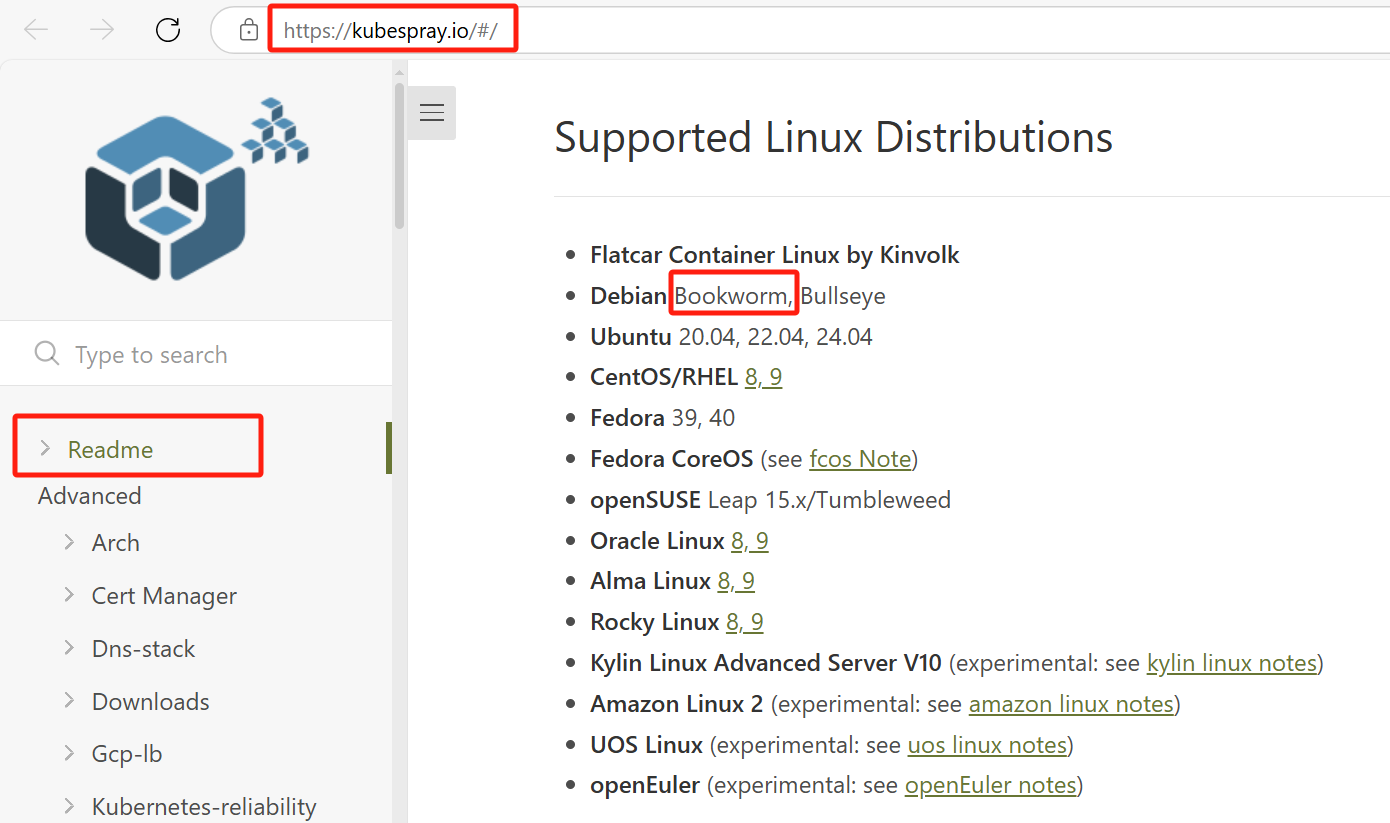
# 查看 CPU 是否支持虚拟化
grep -wE '(vmx|svm)' /proc/cpuinfo (有输出结果代表支持)
# 第一步:安装虚拟化所需软件并启动对应服务
apt update
apt install -y qemu-kvm libvirt-daemon-system libvirt-clients virtinst guestfs-tools
# qemu-kvm kvm 虚拟化的核心后端
# libvirt-daemon-system libvirt 守护进程(管理虚拟机的服务)
# libvirt-clients libvirt 的命令行工具 (如 virsh)
# virtinst 创建虚拟机的工具 (如 virt-install)
# guestfs-tools 在不启动虚拟机的情况下修改虚拟磁盘(如重置 root 密码)
# bridge-utils 网络桥接工具(可选,本文以 nmcli 创建网桥为例)
# 启动 libvirtd 服务
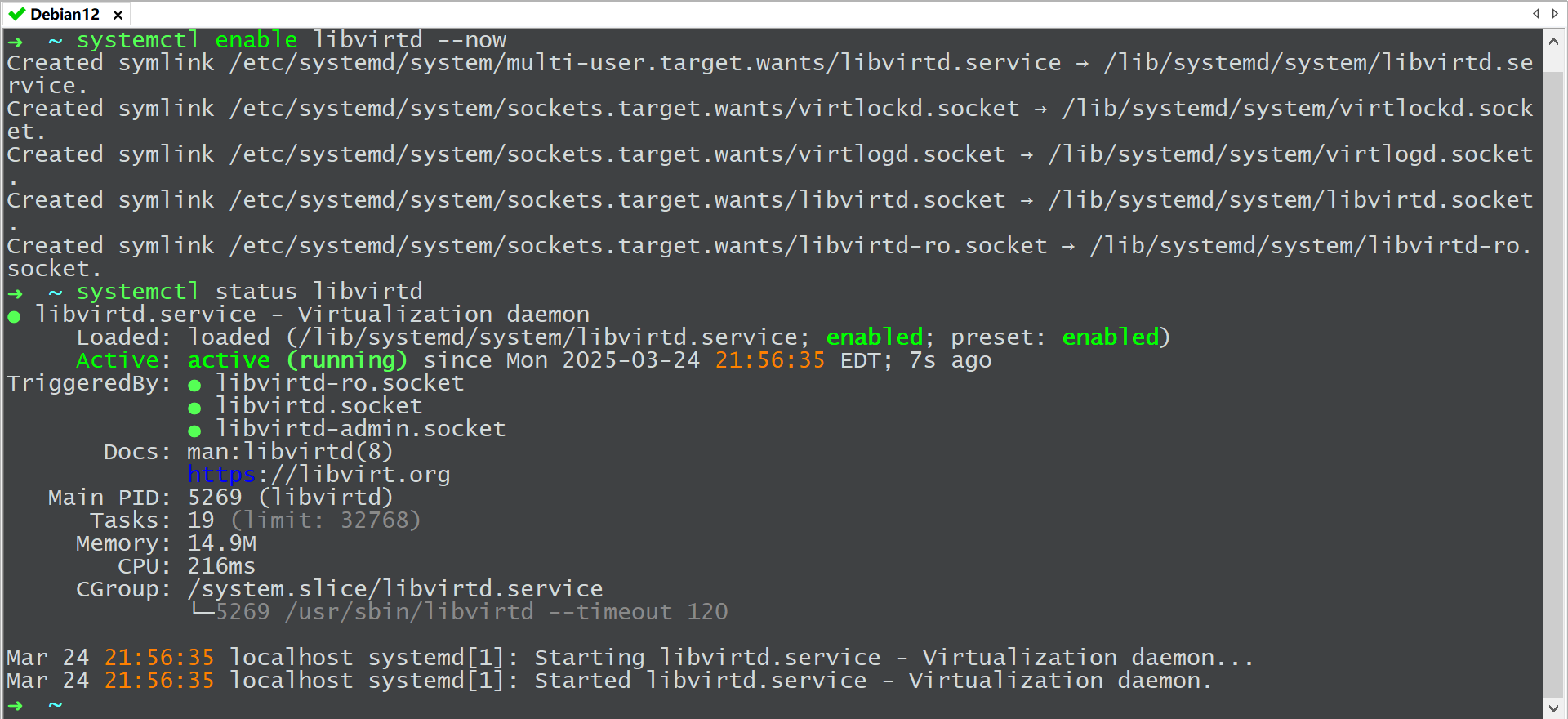
# 第二步:下载 debian12-qcow2 镜像并创建部署 k8s 所需的虚拟机
# 下载 qcow2 镜像
wget https://cloud.debian.org/images/cloud/bookworm/20250316-2053/debian-12-generic-amd64-20250316-2053.qcow2
# 重置虚拟磁盘 root 密码

# 查看根分区只有不到3G,因此需要扩容虚拟硬盘的根分区
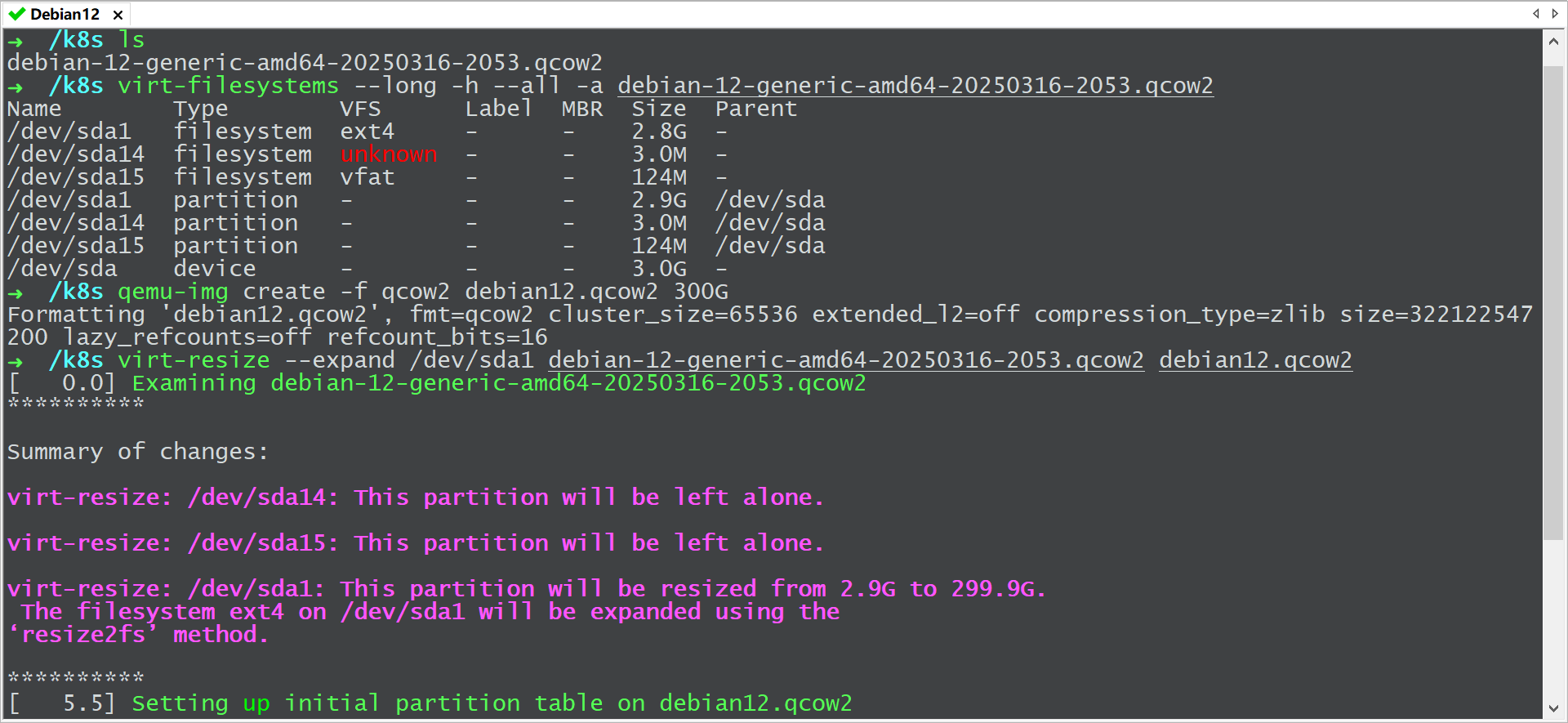

# 复制虚拟机对应的磁盘文件

# 创建连接虚拟机的网桥

# 由于 4.1.0 版本的 virt-install 还不支持 debian12 参数,所以可以用 --os-type linux --os-variant generic 参数代替

# 创建虚拟机(宿主机配置高的情况下可增加虚拟机的配置)
# 创建虚拟机后也可通过 virsh setvcpus 和 virsh setmem 命令对虚拟机进行动态扩容
# virsh setvcpus k8s-master1 2 --live(将 k8s-master1 的 cpu 扩容至2核,--config 可永久生效)
# virsh setmem k8s-master1 $((4*1024*1024)) --live (将 k8s-master1 的 mem 扩容至4G,--config 可永久生效)
# 若虚拟机不支持动态扩容,可将虚拟机关机后使用 virsh edit <vm-name/vm-id> 修改 xml 文件后再重启
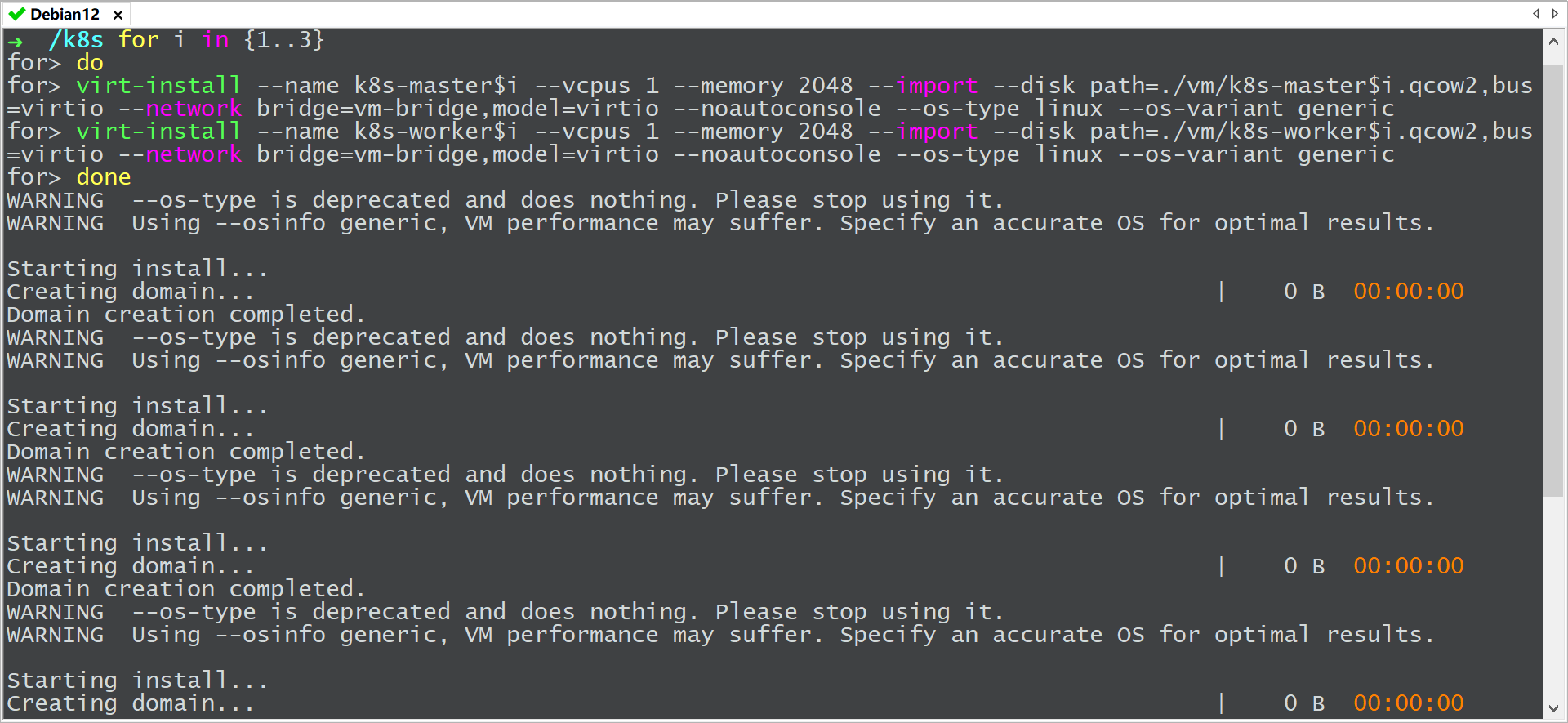

# 设置虚拟机为下次开机自启动

# 给虚拟机配置 IP 和主机名并在宿主机上配置解析

# 安装后续所需软件
apt -y install sshpass git python3-pip
# k8s 虚拟机默认不能访问外网

# 宿主机配置 SNAT 规则使其 k8s 虚拟机可以访问外网
sysctl -w net.ipv4.ip_forward=1
echo "net.ipv4.ip_forward=1" >/etc/sysctl.d/k8s.conf
iptables -t nat -A POSTROUTING -s 192.168.250.0/24 -o eth0 -j MASQUERADE
mkdir -pv /etc/iptables
iptables-save >/etc/iptables/rules.v4
# iptables 永久生效
apt install iptables-persistent -y
netfilter-persistent save
# 配置免密登录
ssh-keygen -t rsa -N '' -f ~/.ssh/id_rsa -b 2048
for i in {1..3}
do
sshpass -p'1' ssh-copy-id -i ~/.ssh/id_rsa.pub k8s-master$i
sshpass -p'1' ssh-copy-id -i ~/.ssh/id_rsa.pub k8s-worker$i
done
# 验证 k8s 虚拟机是否可以访问外网
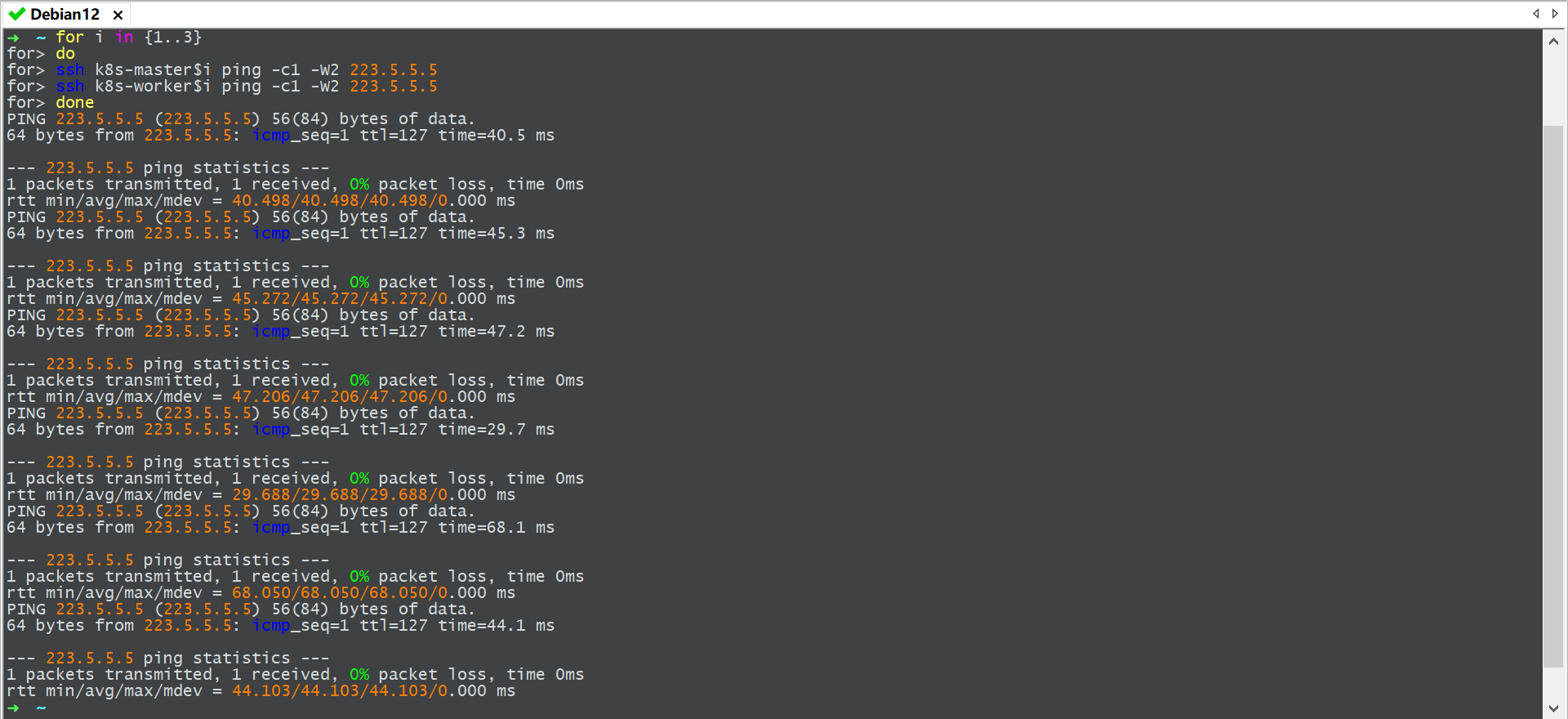
# 虚拟机配置 apt 源并安装基础软件
for i in {1..3}
do
ssh k8s-master$i 'rm -rf /etc/apt/sources.list.d/*'
ssh k8s-worker$i 'rm -rf /etc/apt/sources.list.d/*'
scp /etc/apt/sources.list k8s-master$i:/etc/apt
scp /etc/apt/sources.list k8s-worker$i:/etc/apt
ssh k8s-master$i 'echo "nameserver 223.5.5.5" | tee /etc/resolv.conf'
ssh k8s-worker$i 'echo "nameserver 223.5.5.5" | tee /etc/resolv.conf'
ssh k8s-master$i apt update
ssh k8s-worker$i apt update
ssh k8s-master$i apt -y install vim bash-completion network-manager net-tools
ssh k8s-worker$i apt -y install vim bash-completion network-manager net-tools
done
# 虚拟机网络配置
for i in {1..3}
do
ssh k8s-master$i "nmcli con modify ens3 ipv4.addresses 192.168.250.1$i ipv4.gateway 192.168.250.1 ipv4.method manual connection.autoconnect yes ipv4.dns 223.5.5.5 +ipv4.dns 8.8.8.8"
ssh k8s-worker$i "nmcli con modify ens3 ipv4.addresses 192.168.250.2$i ipv4.gateway 192.168.250.1 ipv4.method manual connection.autoconnect yes ipv4.dns 223.5.5.5 +ipv4.dns 8.8.8.8"
ssh k8s-master$i "nmcli con reload && nmcli con up ens3"
ssh k8s-worker$i "nmcli con reload && nmcli con up ens3"
done
# 下载使用 kubespray
git clone -b release-2.23 https://github.com/kubernetes-sigs/kubespray.git
cd kubespray/
echo "ansible_ssh_pass: 1" >> inventory/sample/group_vars/all/all.yml
cat >inventory/sample/inventory.ini <<END
[all]
k8s-master1 ansible_host=192.168.250.11
k8s-master2 ansible_host=192.168.250.12
k8s-master3 ansible_host=192.168.250.13
k8s-worker1 ansible_host=192.168.250.21
k8s-worker2 ansible_host=192.168.250.22
k8s-worker3 ansible_host=192.168.250.23
[kube-master]
k8s-master1 ansible_host=192.168.250.11
k8s-master2 ansible_host=192.168.250.12
k8s-master3 ansible_host=192.168.250.13
[etcd]
k8s-master1
k8s-master2
k8s-master3
[kube-node]
k8s-master1
k8s-master2
k8s-master3
k8s-worker1
k8s-worker2
k8s-worker3
[calico-rr]
[k8s-cluster:children]
kube-master
kube-node
calico-rr
END

# 在虚拟环境中运行 playbook(playbook 脚本默认从境外下载对应软件包,inventory/sample/group_vars/all/all.yml 的 http_proxy 和 https_proxy 参数可修改)
ansible-playbook -i inventory/sample/inventory.ini cluster.yml -u root --private-key=~/.ssh/id_rsa -v
# 执行成功后如下所示(成功后可使用 deactivate 命令退出虚拟环境)
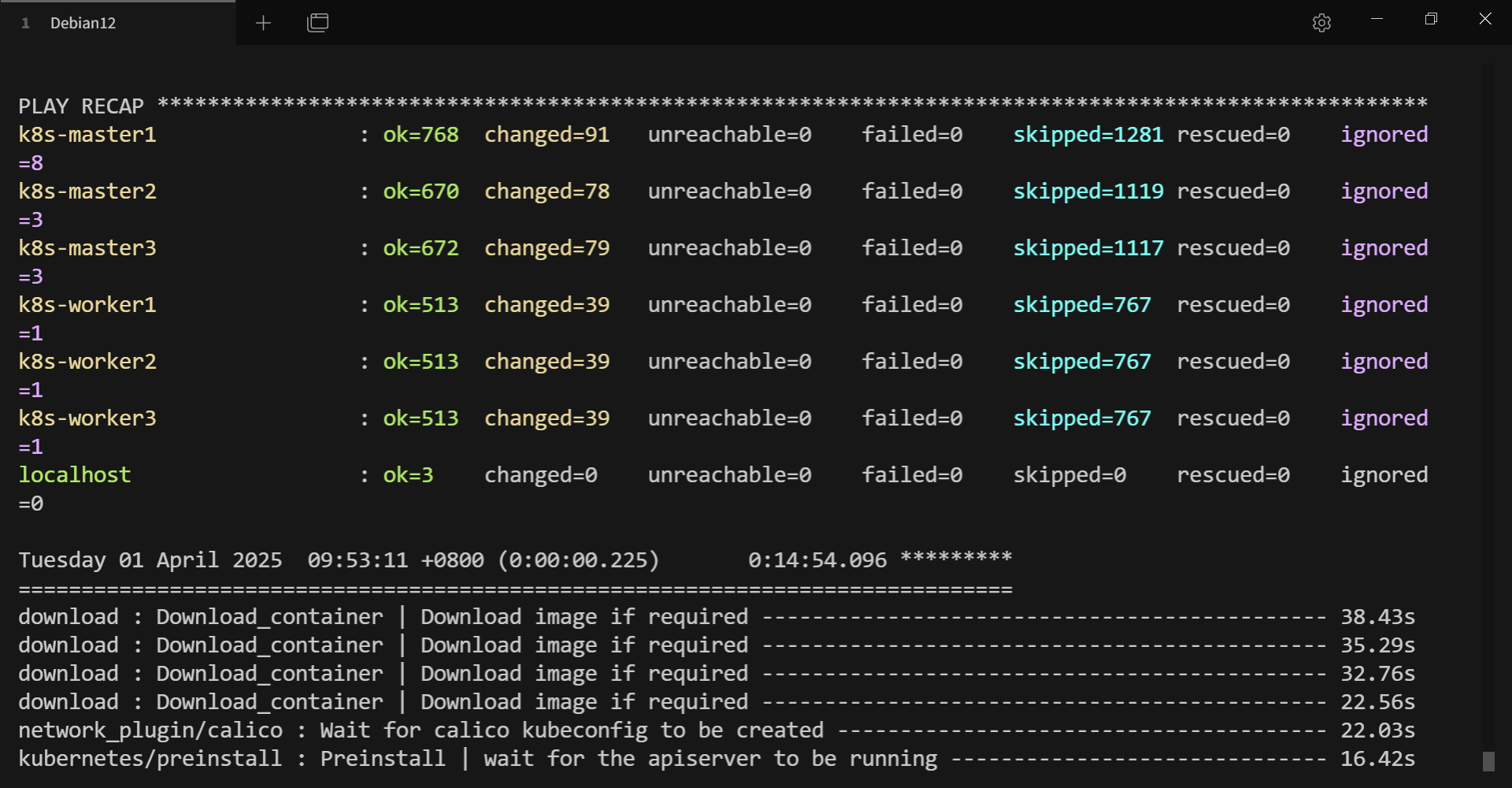
# 查看 k8s 节点状态

# 查看 k8s pod 状态
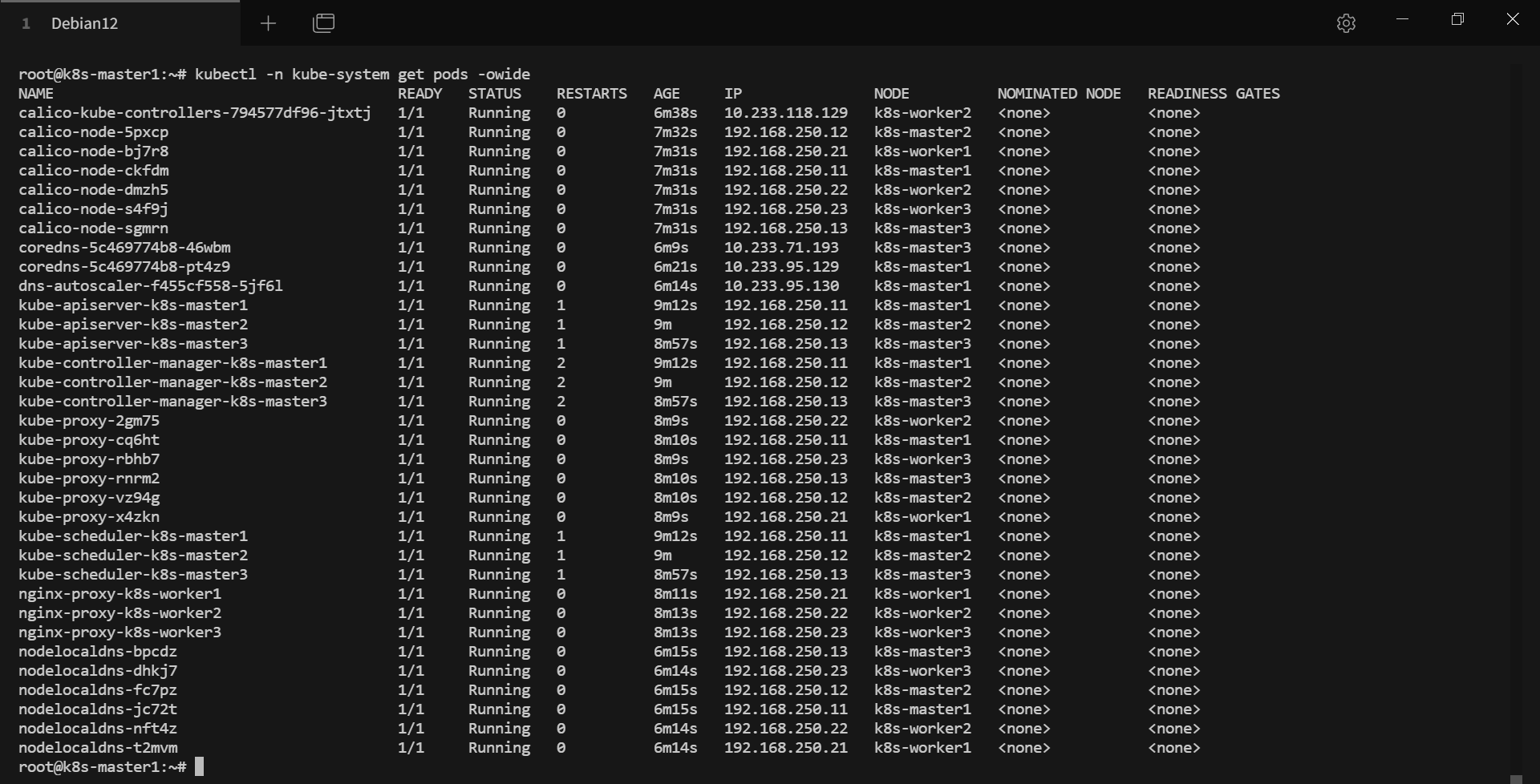
# 查看 pod 详细信息,describe 中包含 pod 的 Conditions 和 Events 等信息
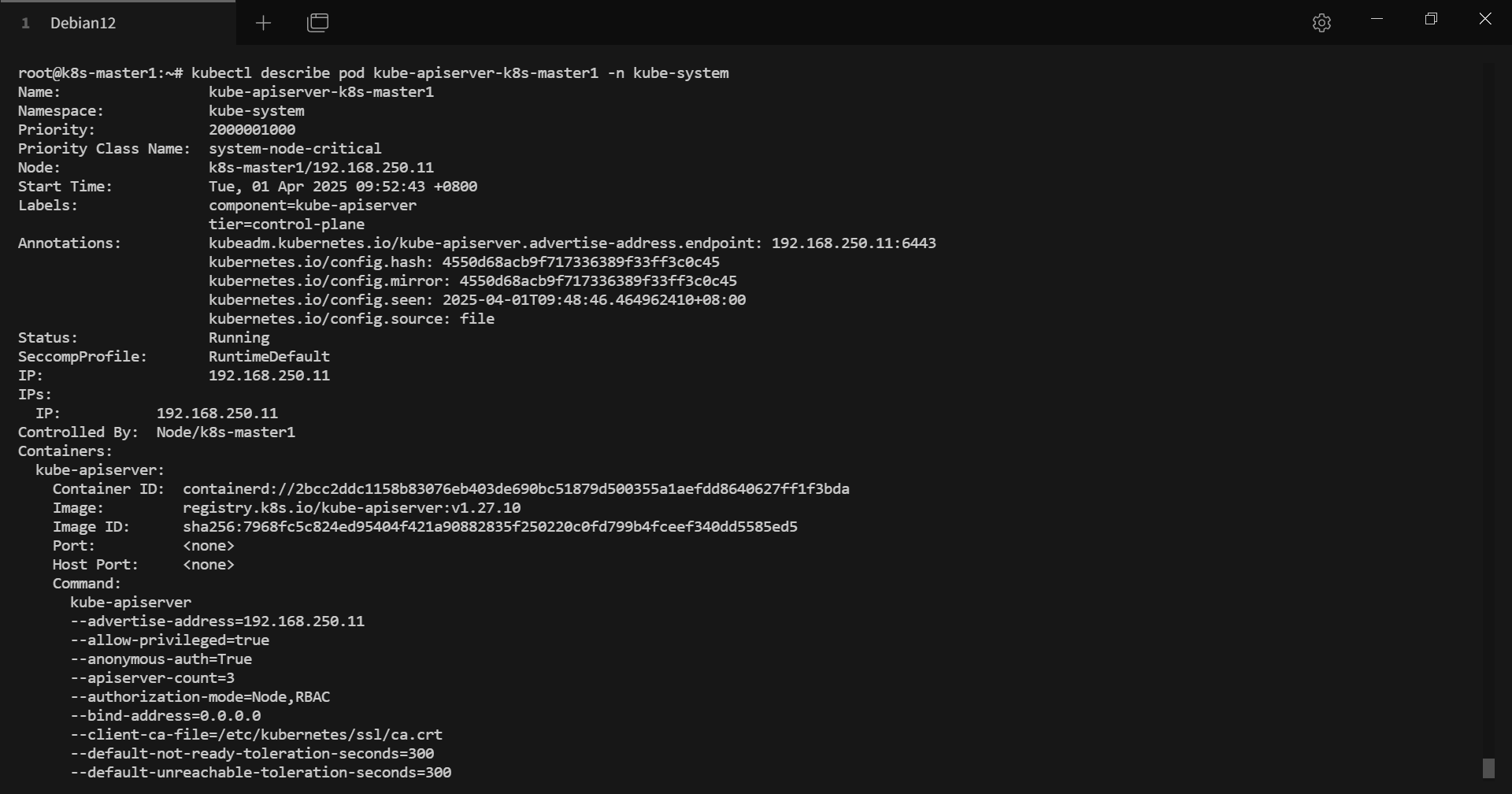
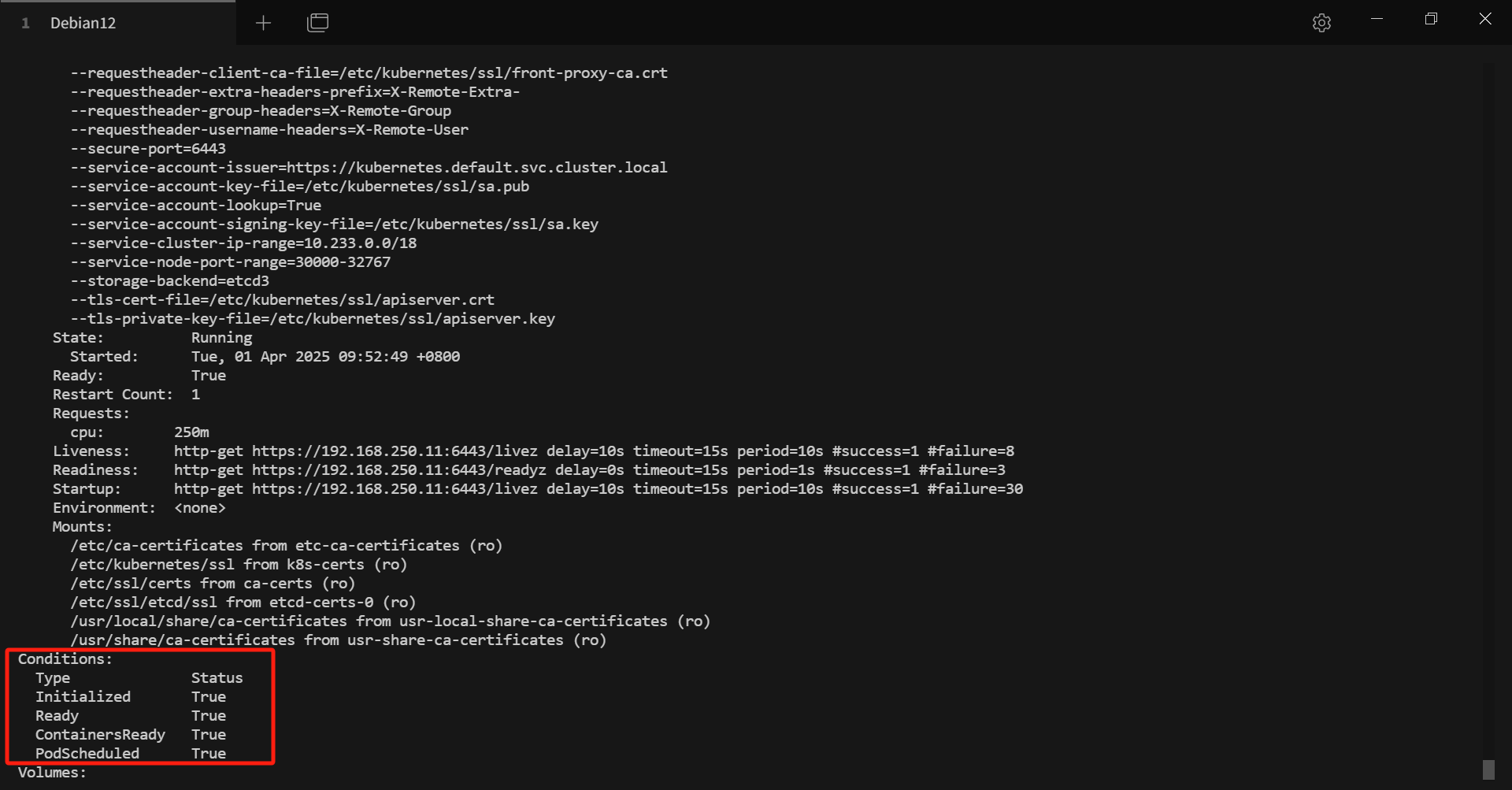
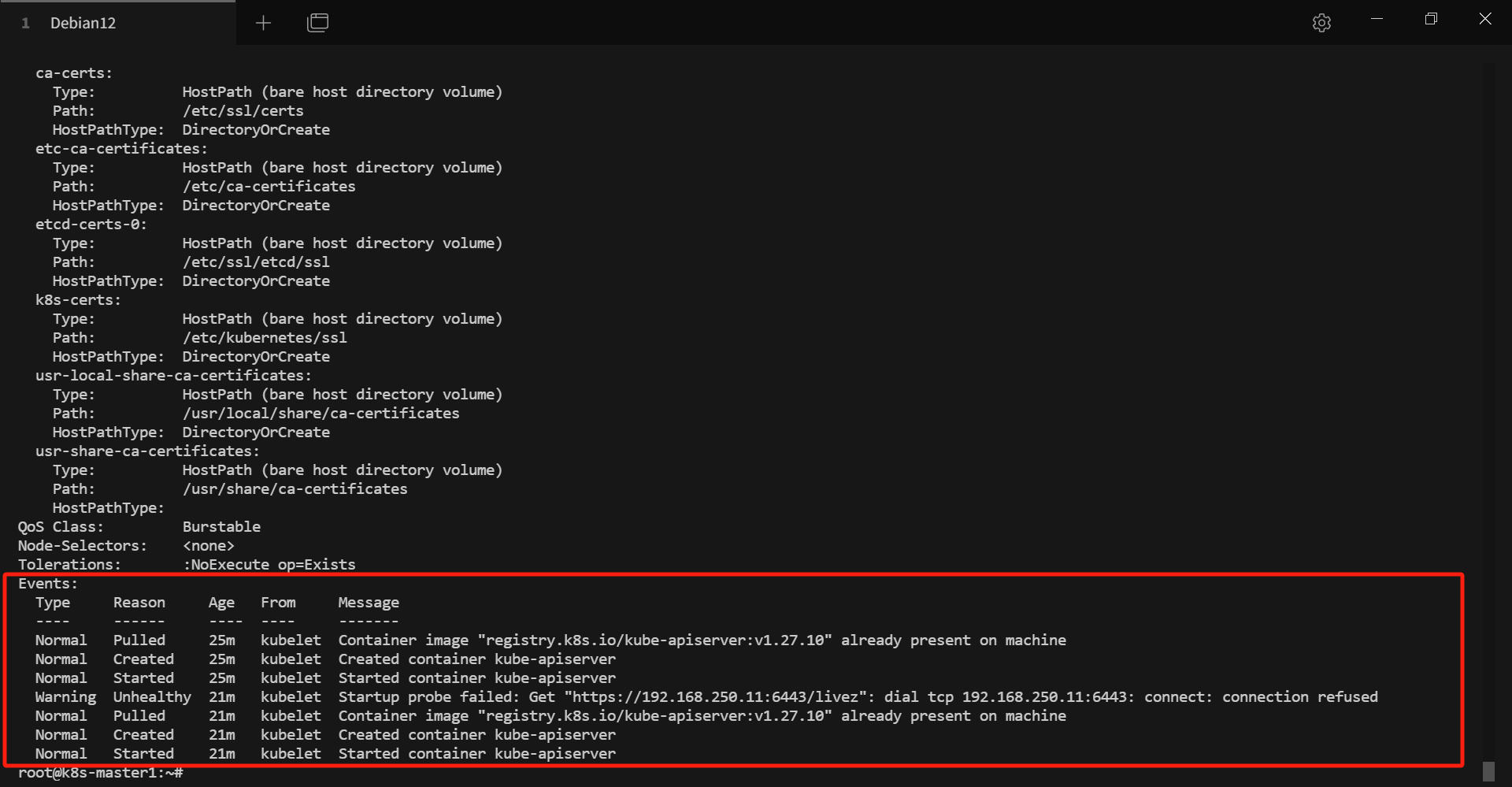
# crictl 查看镜像和运行的容器
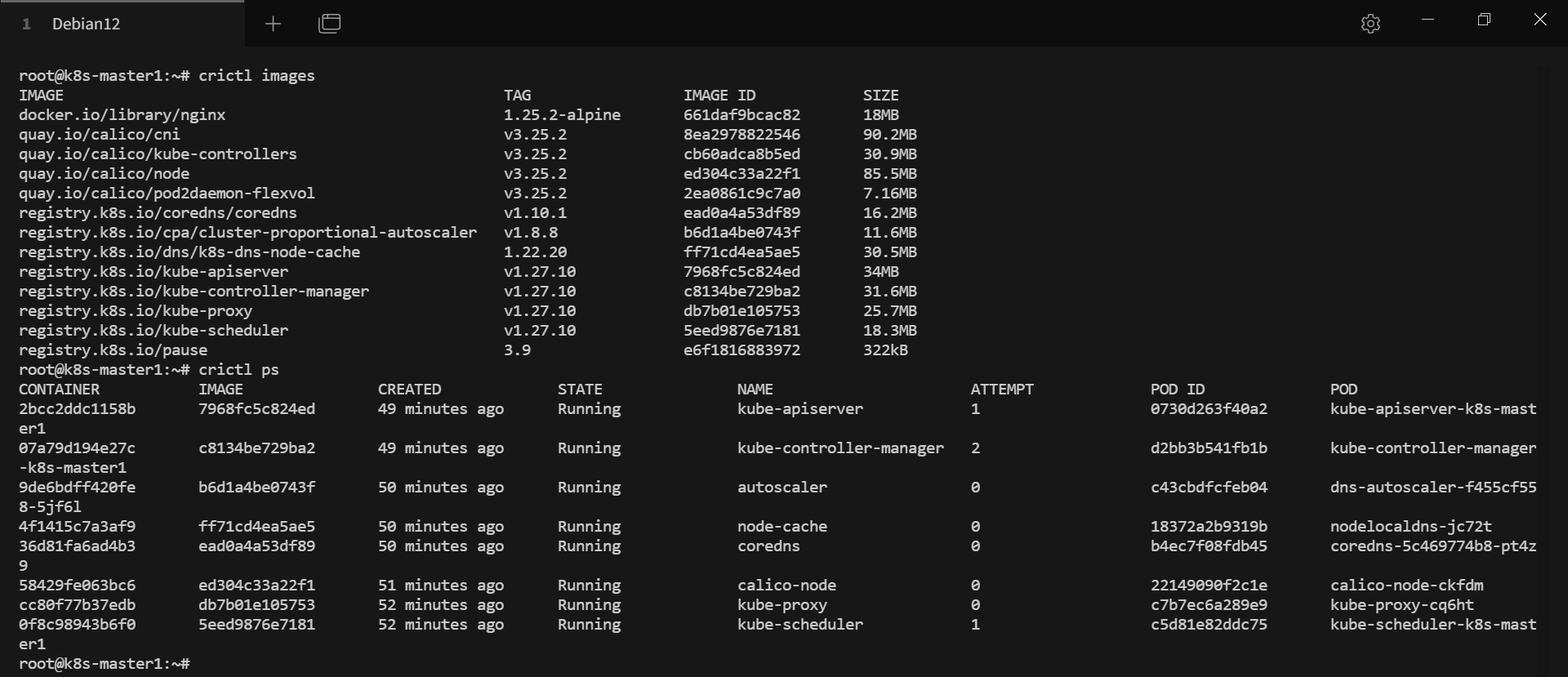
# nerdctl 查看镜像和运行的容器
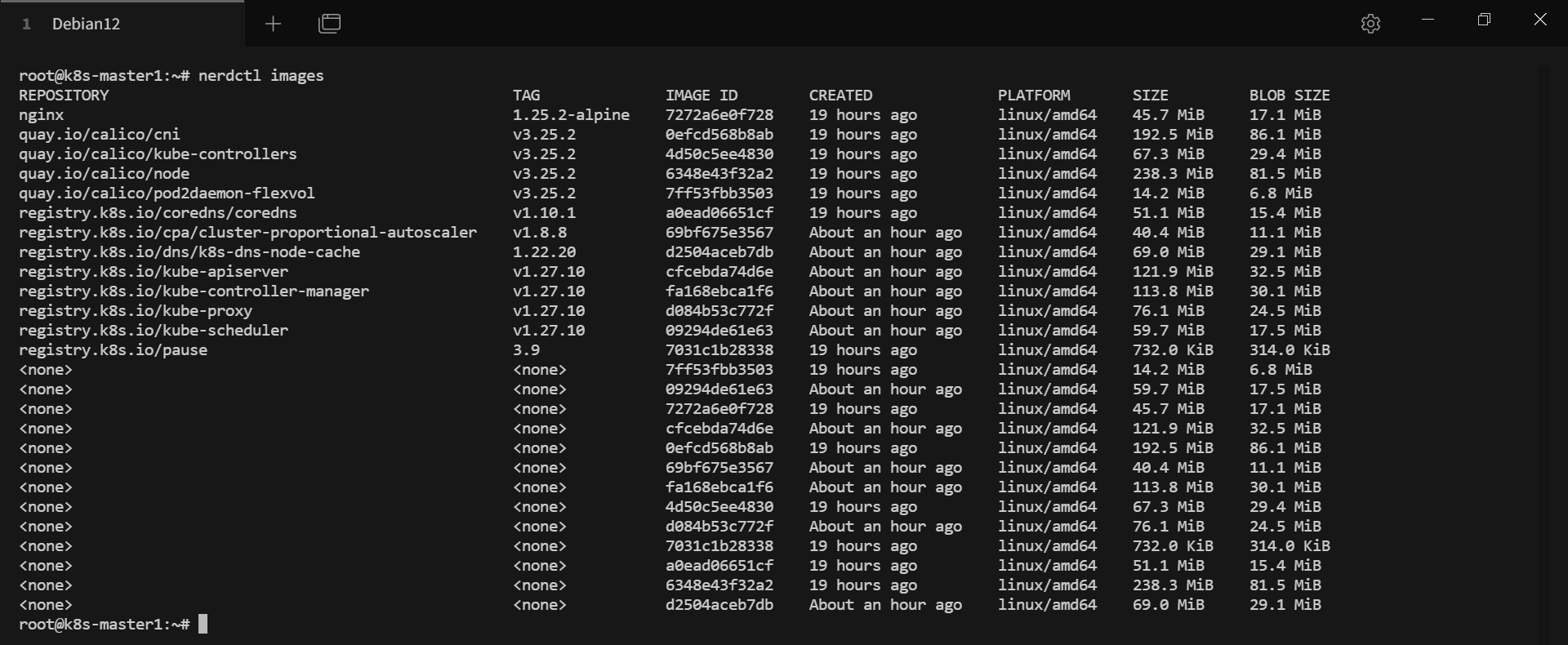
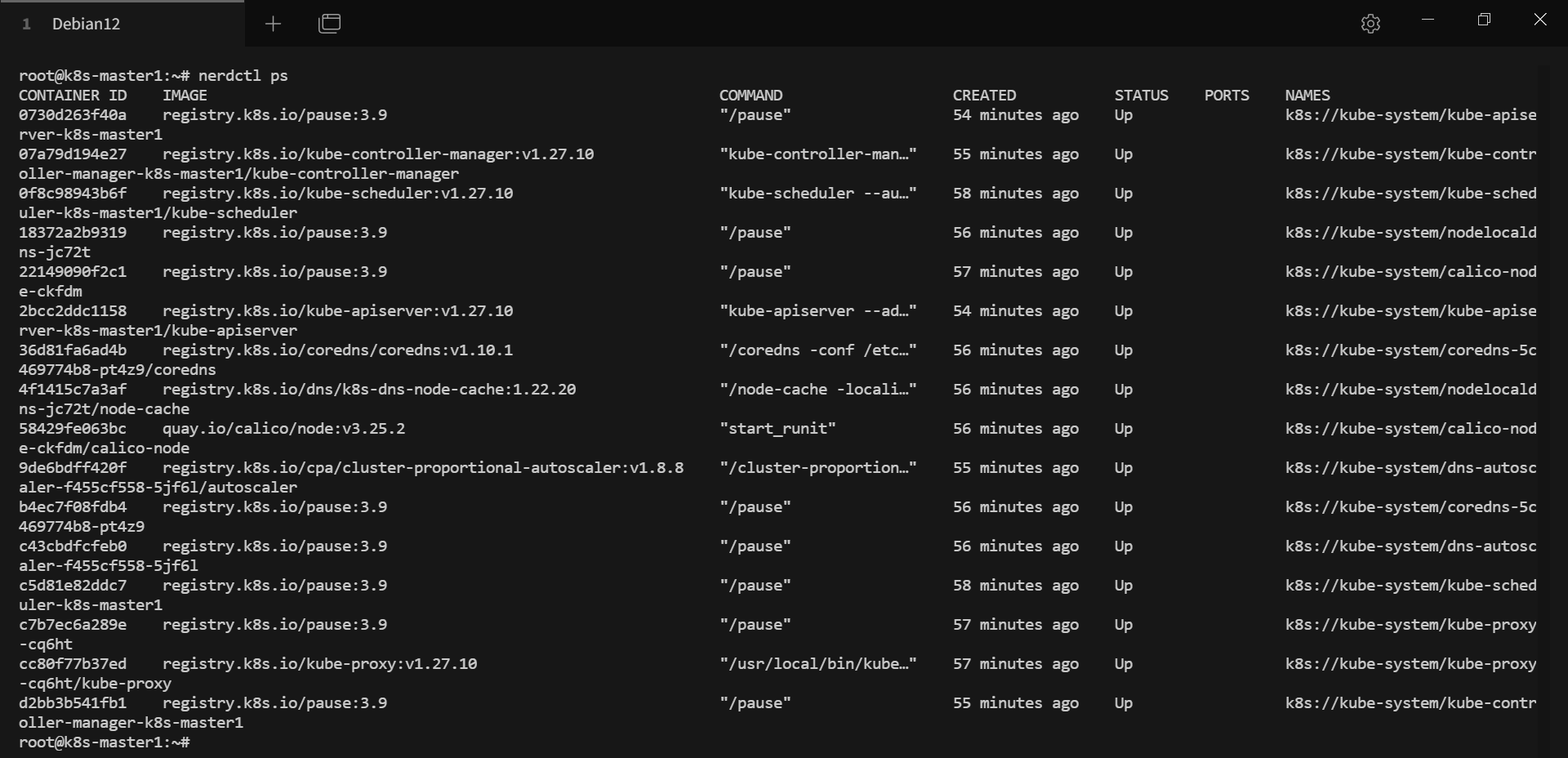
# ctr 查看镜像和运行的容器
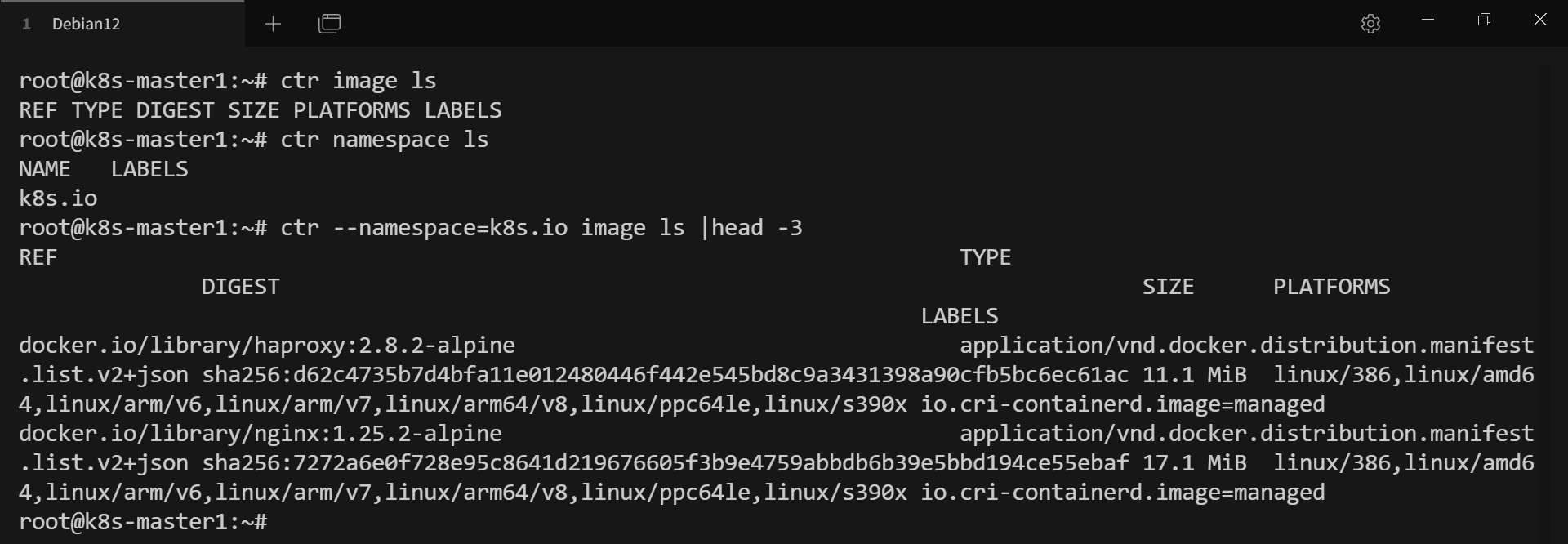
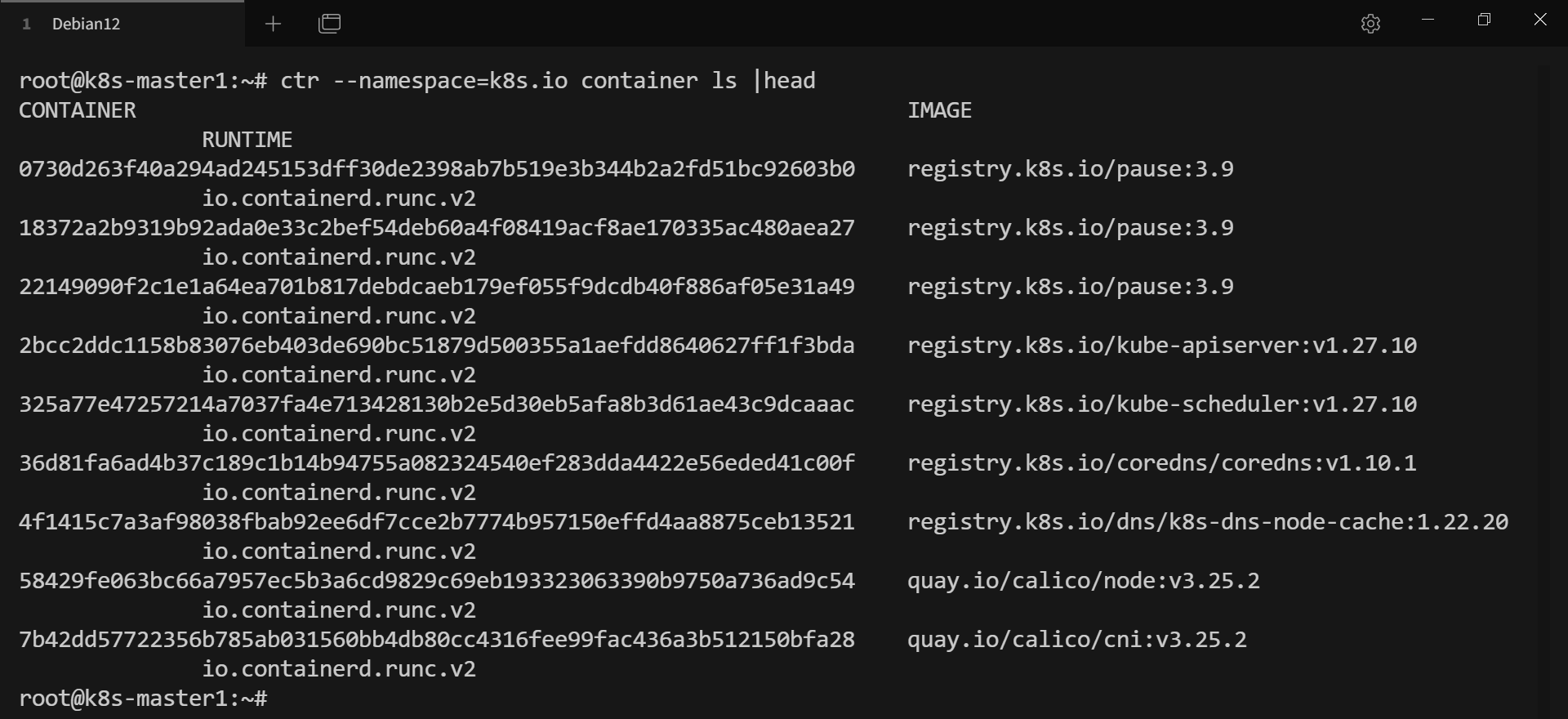
# crictl、nerdctl、ctr 是不同的容器管理工具,主要用于不同的容器运行时环境,区别如下
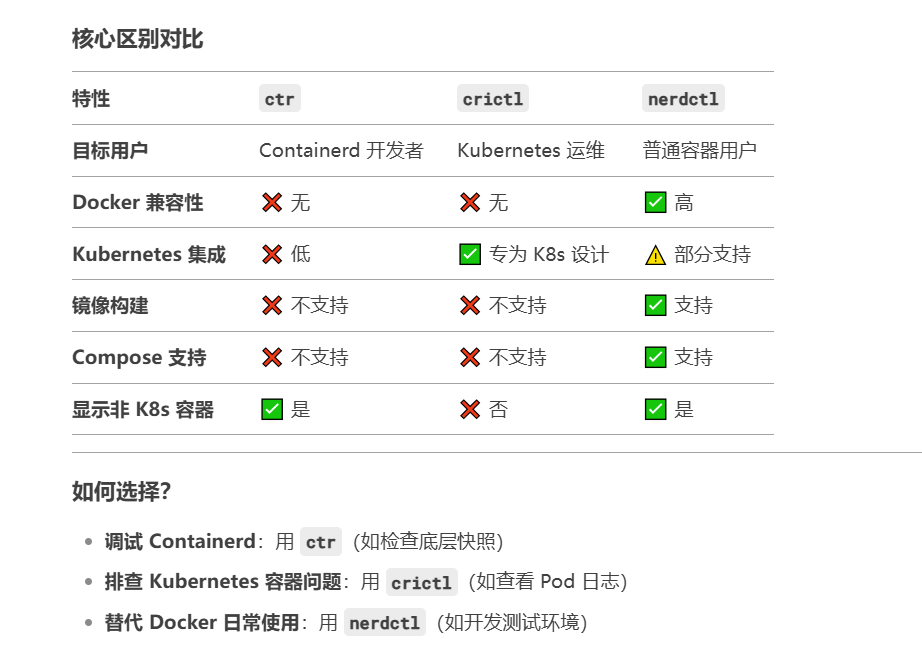
# pod 常用操作
# 获取当前命名空间下的所有 pod
kubectl get pods (-n 指定命名空间, -o 指定格式输出 pod 信息, -w 可以动态查看 pod 信息, -A 查看所有命名空间的 pod)
# 查询 pod 详细信息
kubectl describe pod <podName> -n <namespaceName>
# 创建 pod
kubectl run <podName> --image=<imageName>
# 删除 pod
kubectl delete pod <podName>
# 查看 pod log
kubectl logs <podName>
# 进入容器
kubectl exec -it <podName> -c <containerName> -- /bin/sh
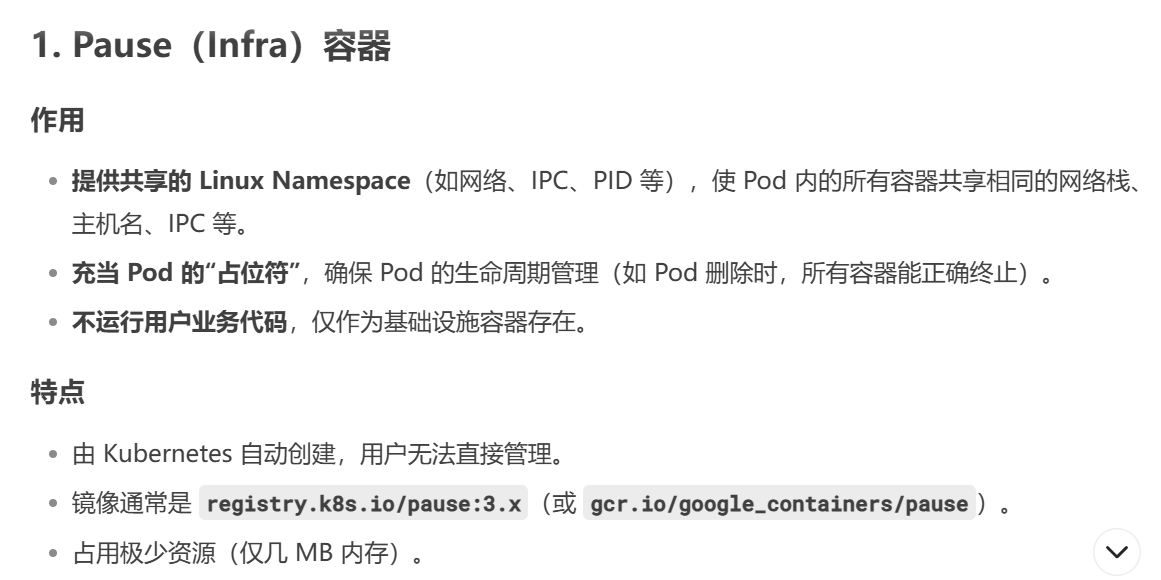
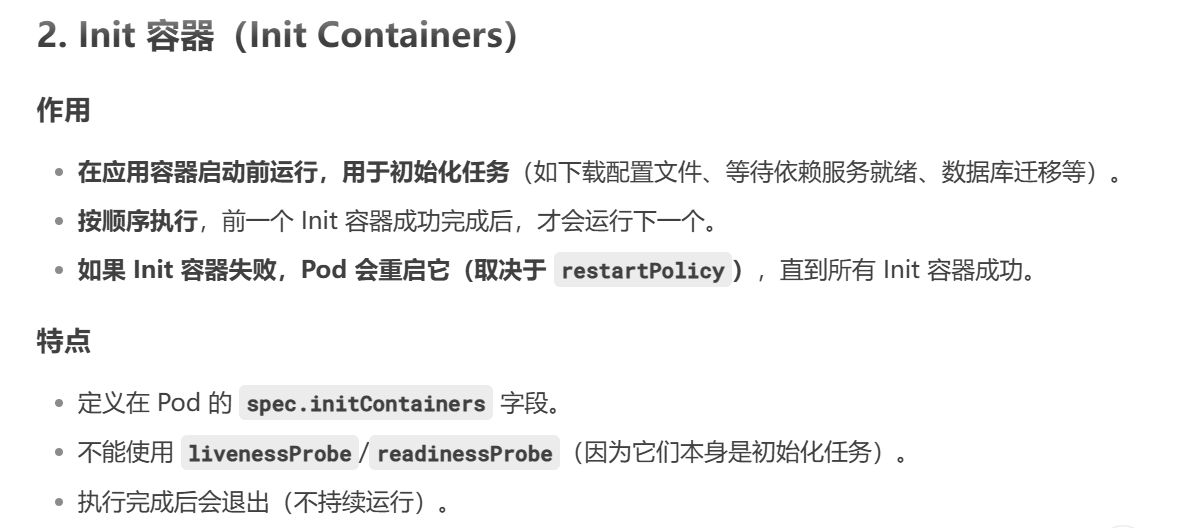
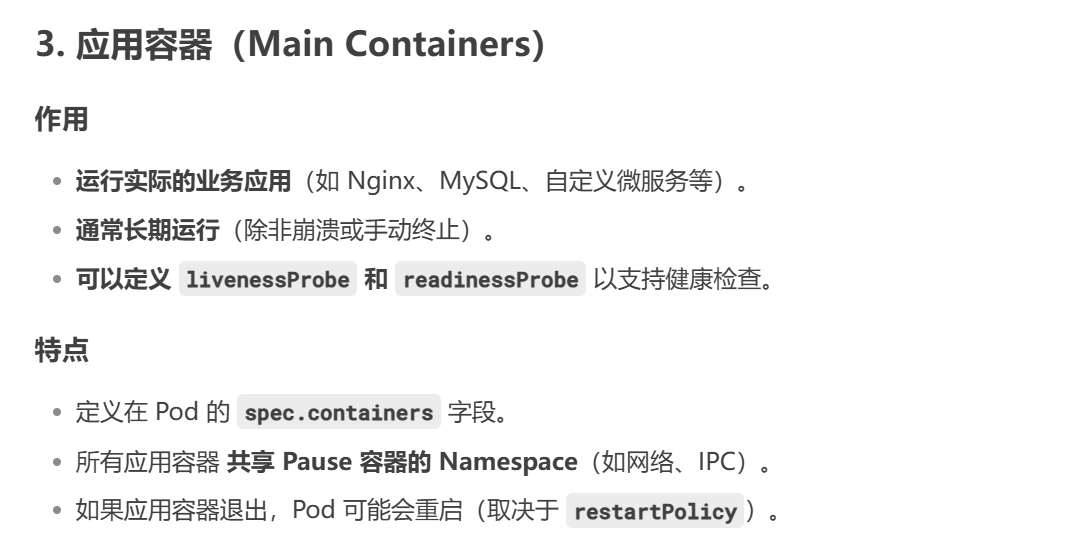
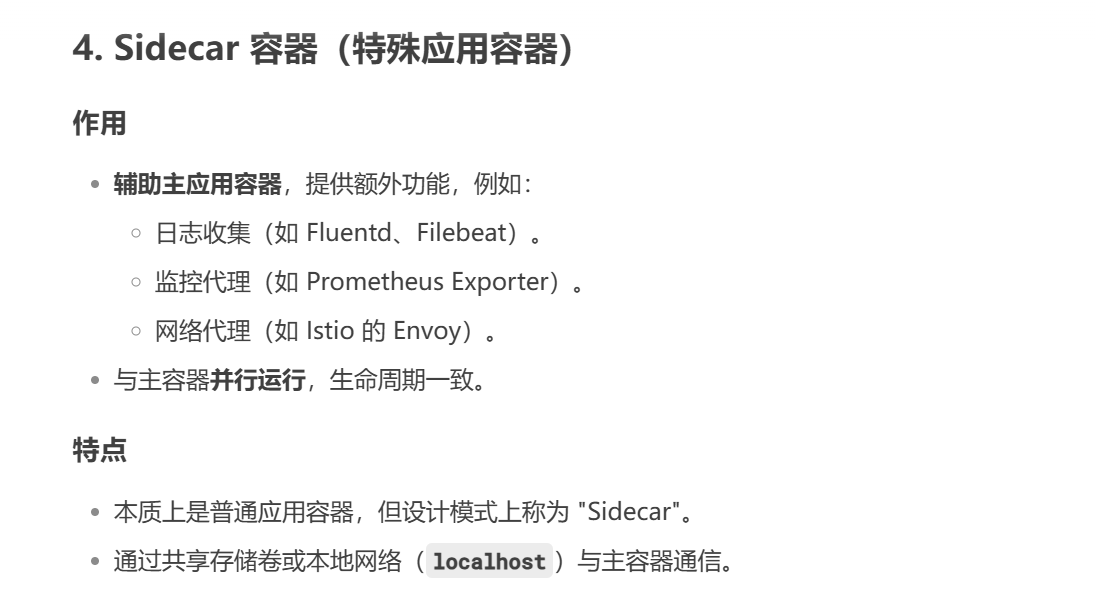
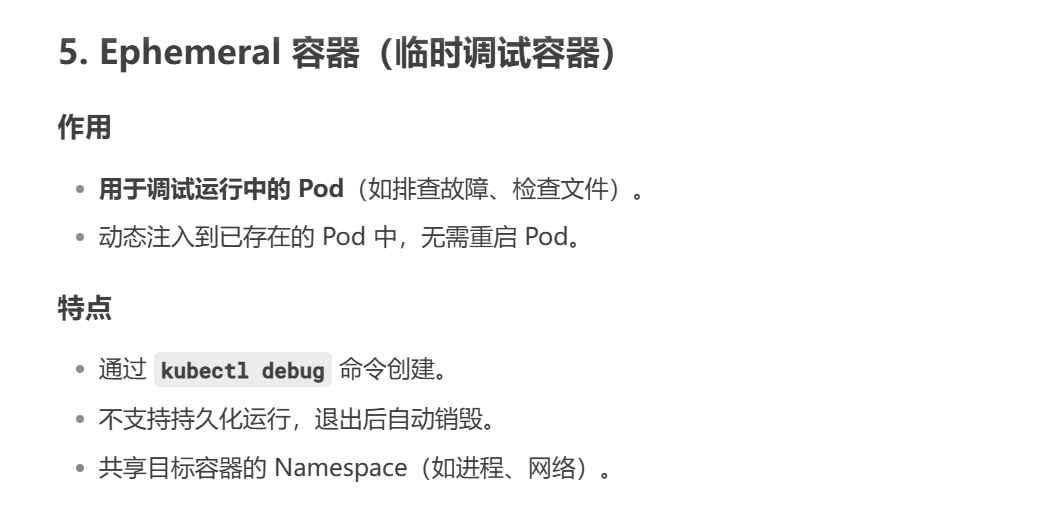
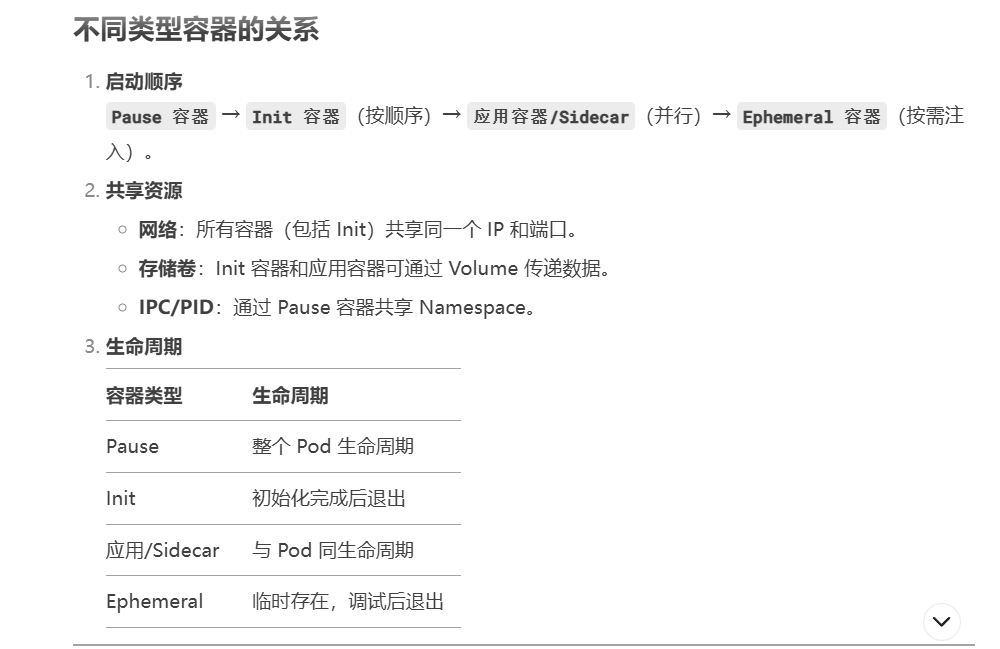
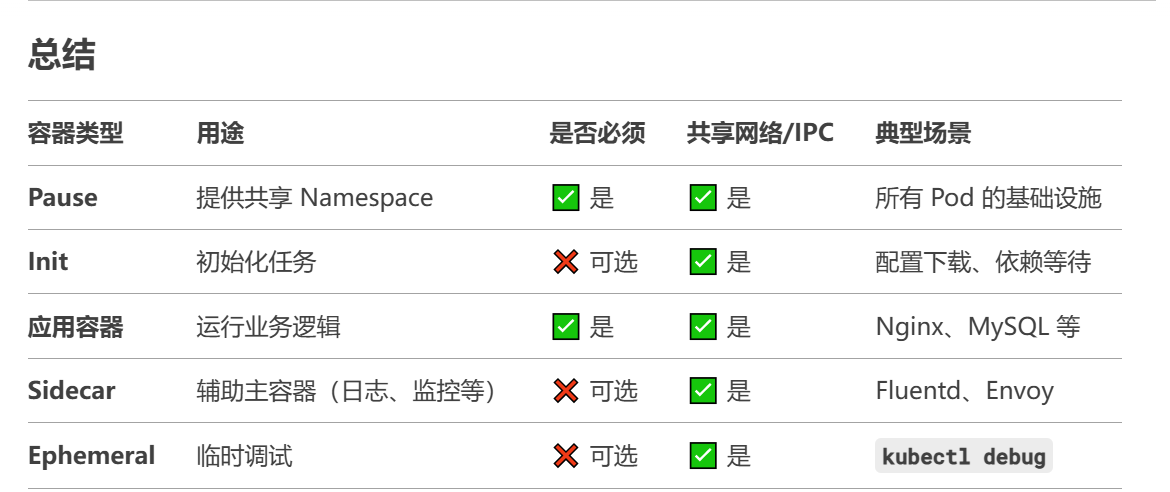
# pod 中容器镜像拉取策略
pod yaml 定义中的 imagePullPolicy 用于设置镜像拉取策略,k8s 支持的三种镜像拉取策略:
1. Always:从远程仓库拉取镜像
2. ifNotPresent:本地有镜像则从本地拉取,本地没有则去远程仓库拉取镜像
3. Never:只从本地拉取镜像,从不去远程仓库拉取镜像,本地没有会报错
imagePullPolicy 默认值说明:
1. 如果镜像 tag 为具体的版本号,默认策略是 ifNotPresent
2. 如果镜像 tag 为 latest,默认策略是 Always
所以 imagePullPolicy 可以针对同一个 pod 下不同的容器采用不同的拉取策略
# pod 重启策略
pod yaml 定义中的 .spec.restartPolicy 用于设置 pod 重启策略,目前支持以下3种策略:
1. Always:当容器终止退出后,总是重启容器,默认策略
2. OnFailure:当容器终止异常退出(退出码非0时)重启容器
3. Never:当容器终止退出时,从不重启容器
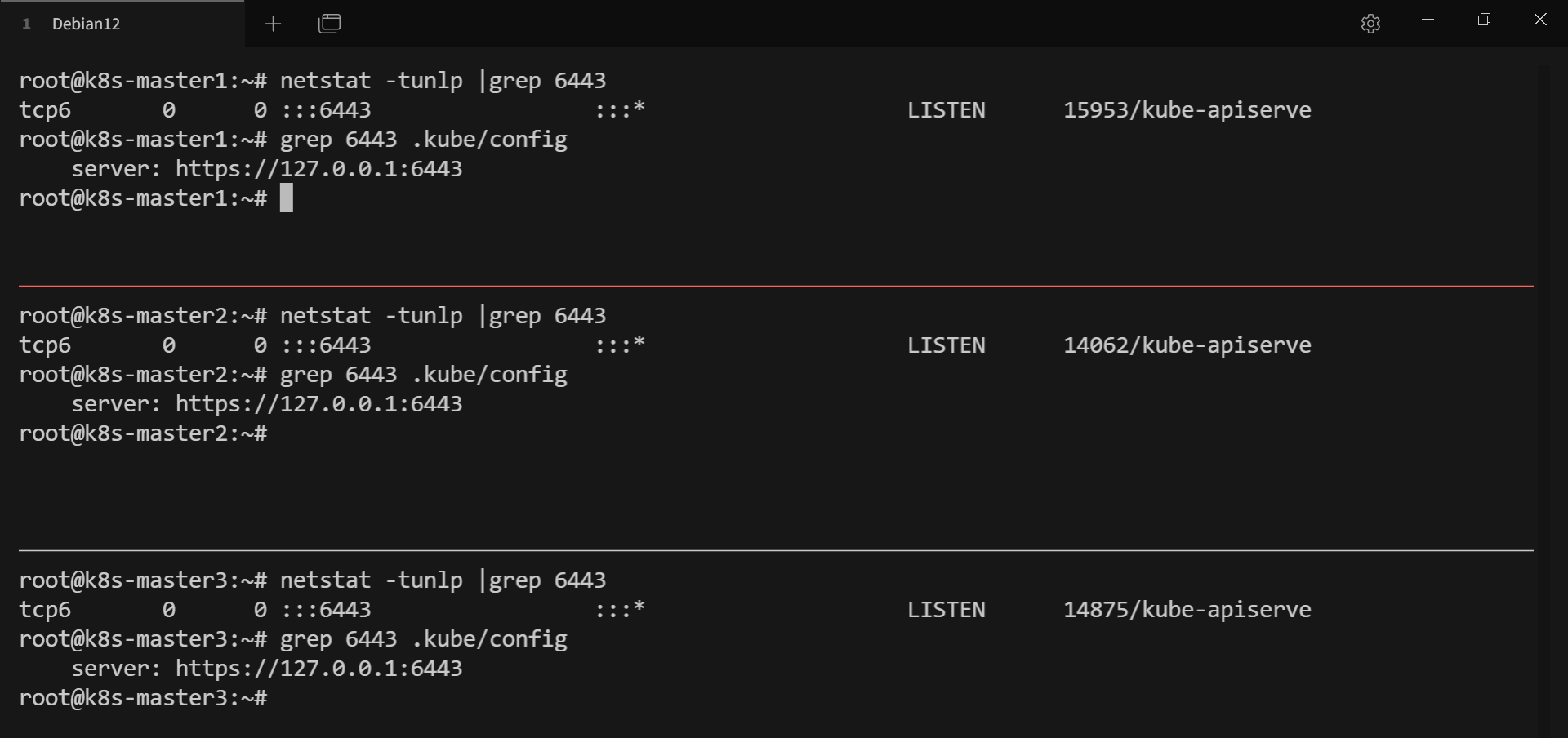
# 安装配置 keepalived + haproxy
mkdir -pv /k8s/kubespray/templates

1 --- 2 - name: Deploy keepalived and haproxy on k8s-master 3 hosts: kube-master 4 vars: 5 # keepalived vars 6 virtual_ip: "192.168.250.15" 7 priority_master: 100 8 vrrp_interface: ens3 9 10 # haproxy vars 11 haproxy_frontend_port: 16443 12 haproxy_backend_port: 6443 13 tasks: 14 - name: install keepalived and haproxy 15 ansible.builtin.apt: 16 update_cache: yes 17 name: "{{ item }}" 18 state: present 19 loop: 20 - keepalived 21 - haproxy 22 23 - name: configure keepalived 24 template: 25 src: templates/keepalived.conf.j2 26 dest: /etc/keepalived/keepalived.conf 27 owner: root 28 group: root 29 mode: 0644 30 notify: restart keepalived 31 32 - name: configure haproxy 33 template: 34 src: templates/haproxy.cfg.j2 35 dest: /etc/haproxy/haproxy.cfg 36 owner: root 37 group: root 38 mode: 0644 39 notify: restart haproxy 40 41 - name: Enable and start services 42 systemd: 43 name: "{{ item }}" 44 state: started 45 enabled: yes 46 loop: 47 - keepalived 48 - haproxy 49 handlers: 50 - name: restart keepalived 51 systemd: 52 name: keepalived 53 state: restarted 54 55 - name: restart haproxy 56 systemd: 57 name: haproxy 58 state: restarted

1 ! Configuration File for keepalived 2 3 global_defs { 4 router_id LVS_DEVEL 5 } 6 7 vrrp_instance VI_1 { 8 state MASTER 9 virtual_router_id 51 10 interface {{ vrrp_interface }} 11 priority {{ priority_master }} 12 advert_int 1 13 authentication { 14 auth_type PASS 15 auth_pass 1111 16 } 17 virtual_ipaddress { 18 {{ virtual_ip }}/24 dev {{ vrrp_interface }} 19 } 20 }

1 global 2 log 127.0.0.1 local0 3 log 127.0.0.1 local1 notice 4 maxconn 4096 5 #chroot /usr/share/haproxy 6 #user haproxy 7 #group haproxy 8 daemon 9 10 defaults 11 log global 12 mode http 13 option httplog 14 option dontlognull 15 retries 3 16 option redispatch 17 timeout connect 5000 18 timeout client 50000 19 timeout server 50000 20 21 frontend stats-front 22 bind *:8081 23 mode http 24 default_backend stats-back 25 26 frontend frontend_k8s_16443 27 bind *:{{ haproxy_frontend_port }} 28 mode tcp 29 timeout client 1h 30 log global 31 option tcplog 32 default_backend backend_k8s_6443 33 acl is_websocket hdr(Upgrade) -i WebSocket 34 acl is_websocket hdr_beg(Host) -i ws 35 36 backend stats-back 37 mode http 38 balance roundrobin 39 stats uri /haproxy/stats 40 stats auth pxcstats:secret 41 42 backend backend_k8s_6443 43 mode tcp 44 timeout queue 1h 45 timeout server 1h 46 timeout connect 1h 47 log global 48 balance roundrobin 49 {% for host in groups['kube-master'] %} 50 server {{ host }} {{ hostvars[host].ansible_host }}:{{ hostvars[host].haproxy_port | default(6443) }} 51 {% endfor %}
# 执行命令:ansible-playbook -i inventory/sample/inventory.ini keepalived-haproxy.yml -v(结果如下所示)
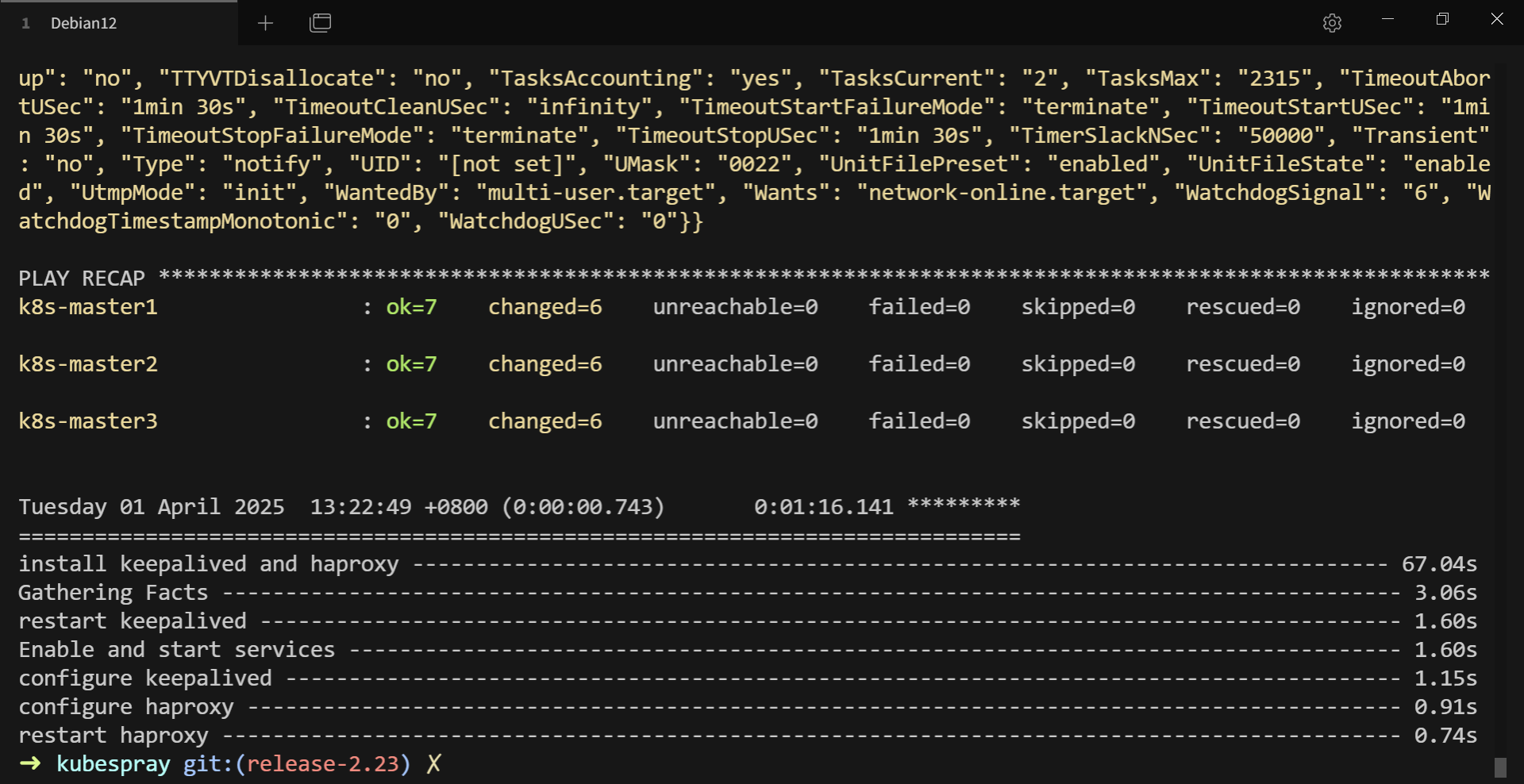
# 修改配置文件
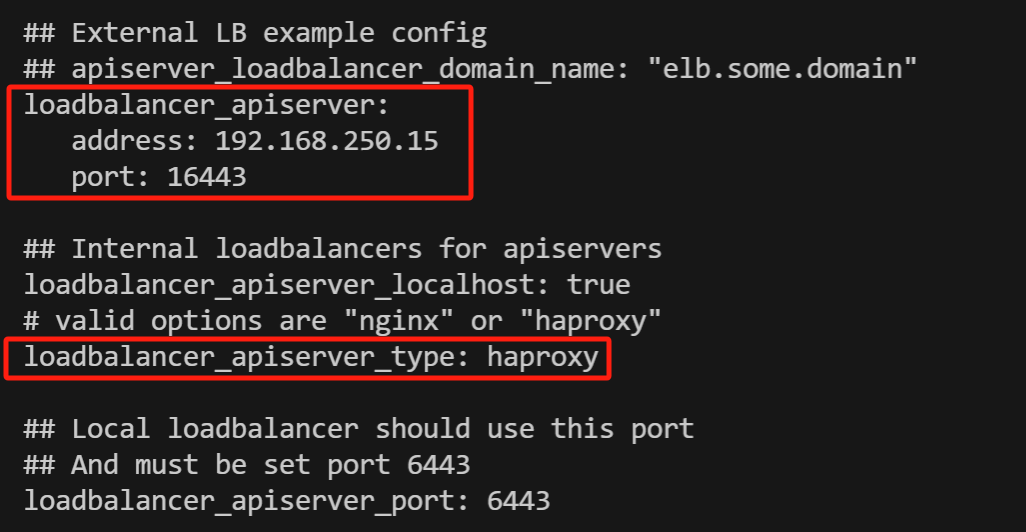
for i in {1..3}
do
ssh k8s-master$i 'sed -i "s|server:.*|server: https://192.168.121.15:16443|" ~/.kube/config'
done
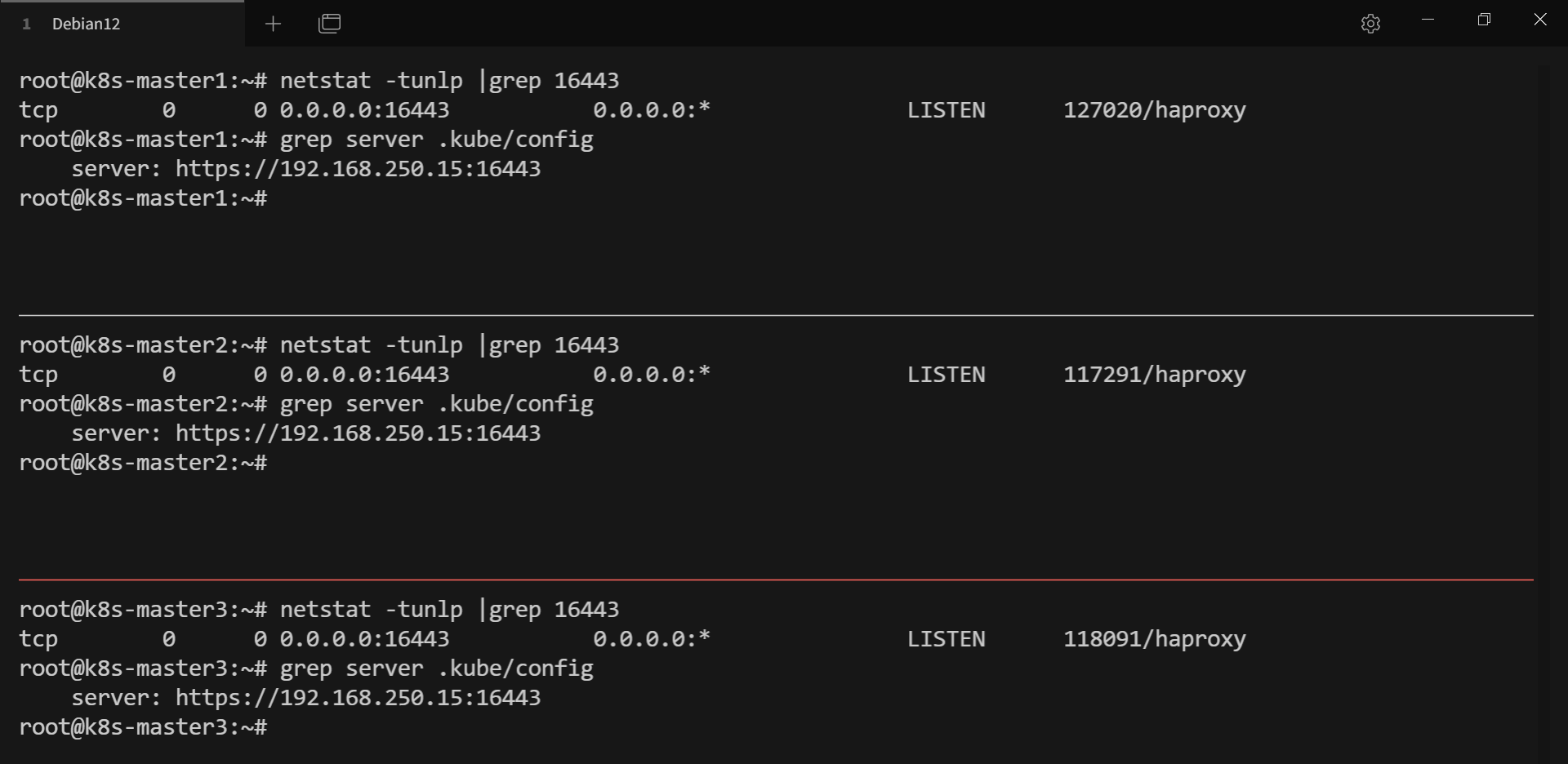
# 再次执行 ansible-playbook -i inventory/sample/inventory.ini cluster.yml -u root --private-key=~/.ssh/id_rsa -v 更新证书
# 查看 VIP 在哪台 master 上
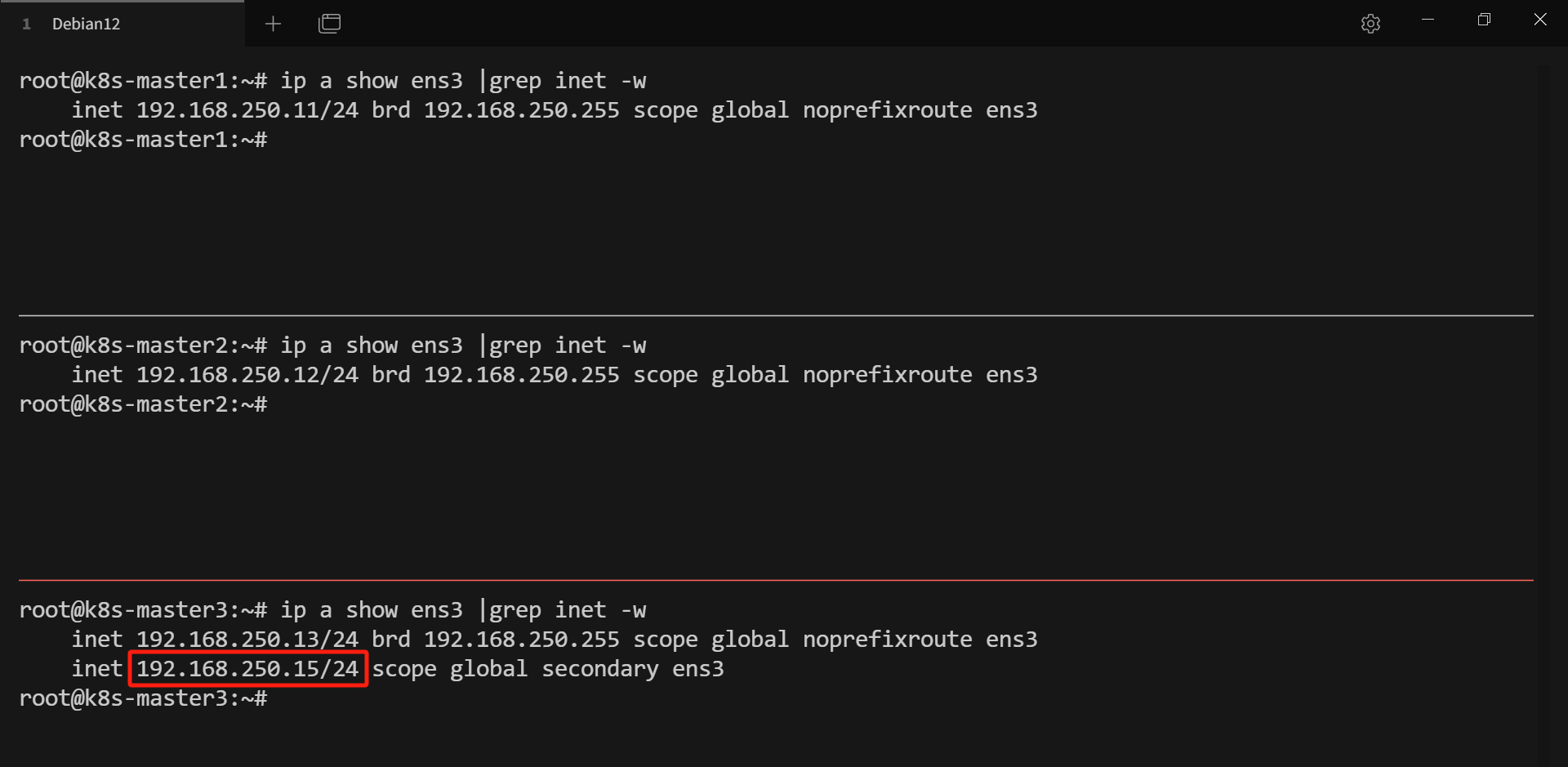
# 将 VIP 对应的 master 节点关机(模拟 master 宕机)
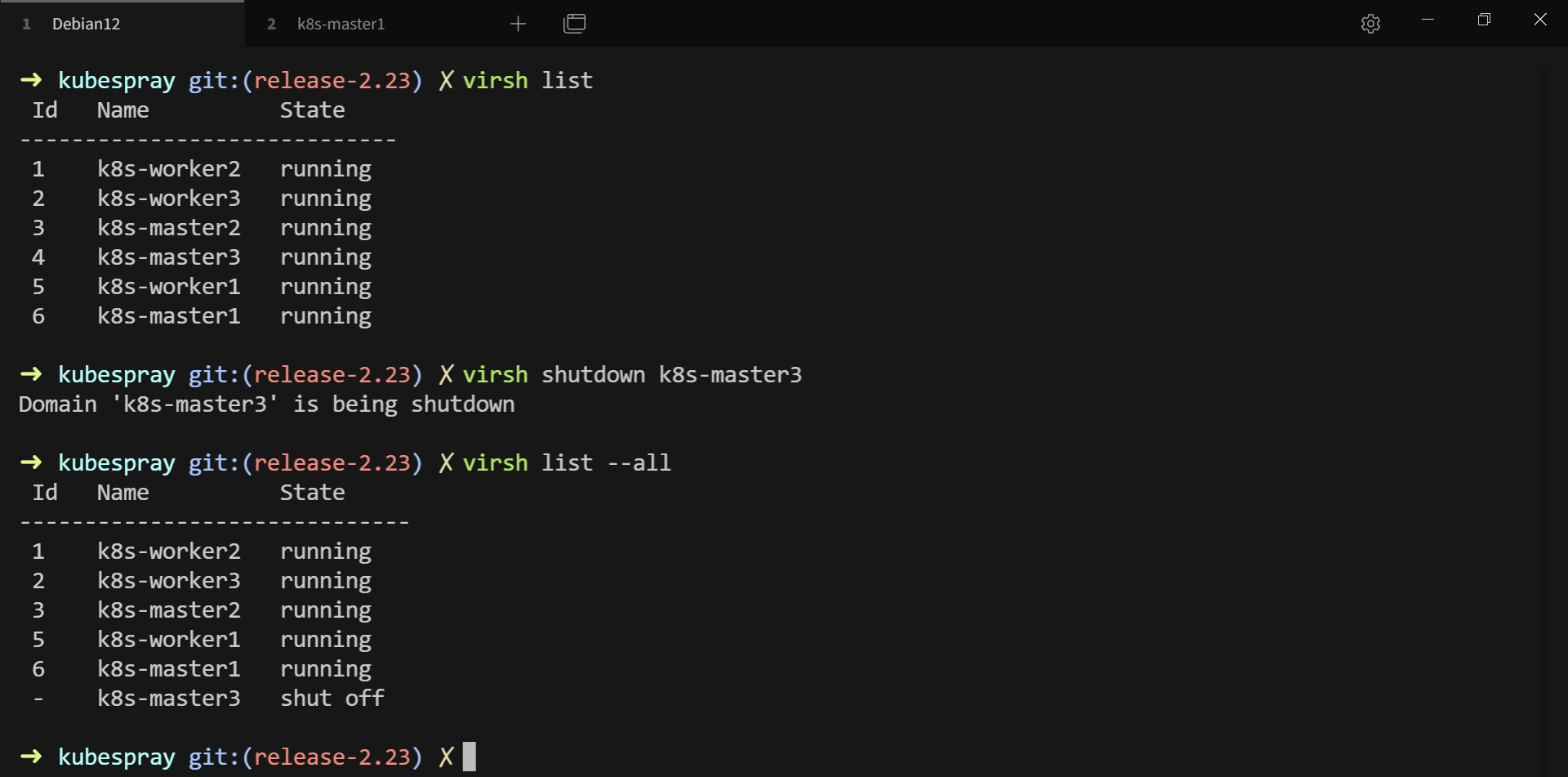
# 此时集群和 kube-apiserver 的访问依旧正常
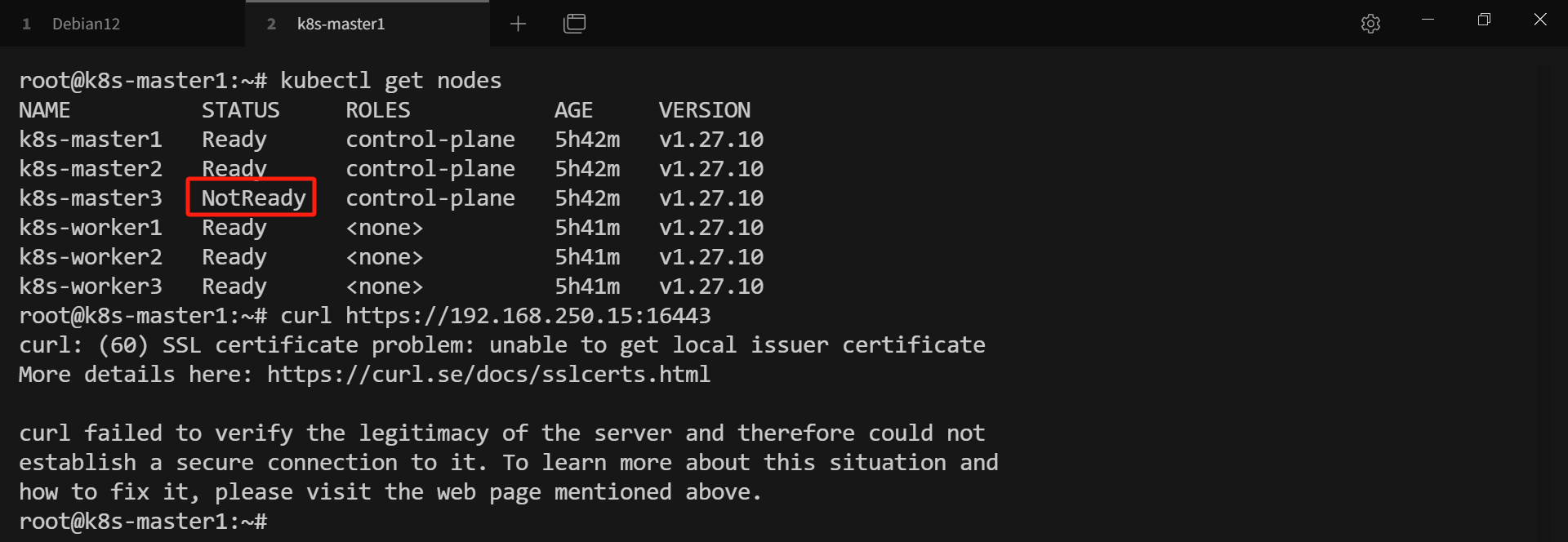
# curl -k https://<apiserver-VIP>:<haproxy-port>/healthz 和 kubectl get --raw /healthz 可查看 kube-apiserver 是否存活

# 并且 VIP 已转移到其它 master 节点,至此 k8s 的高可用集群已部署完成
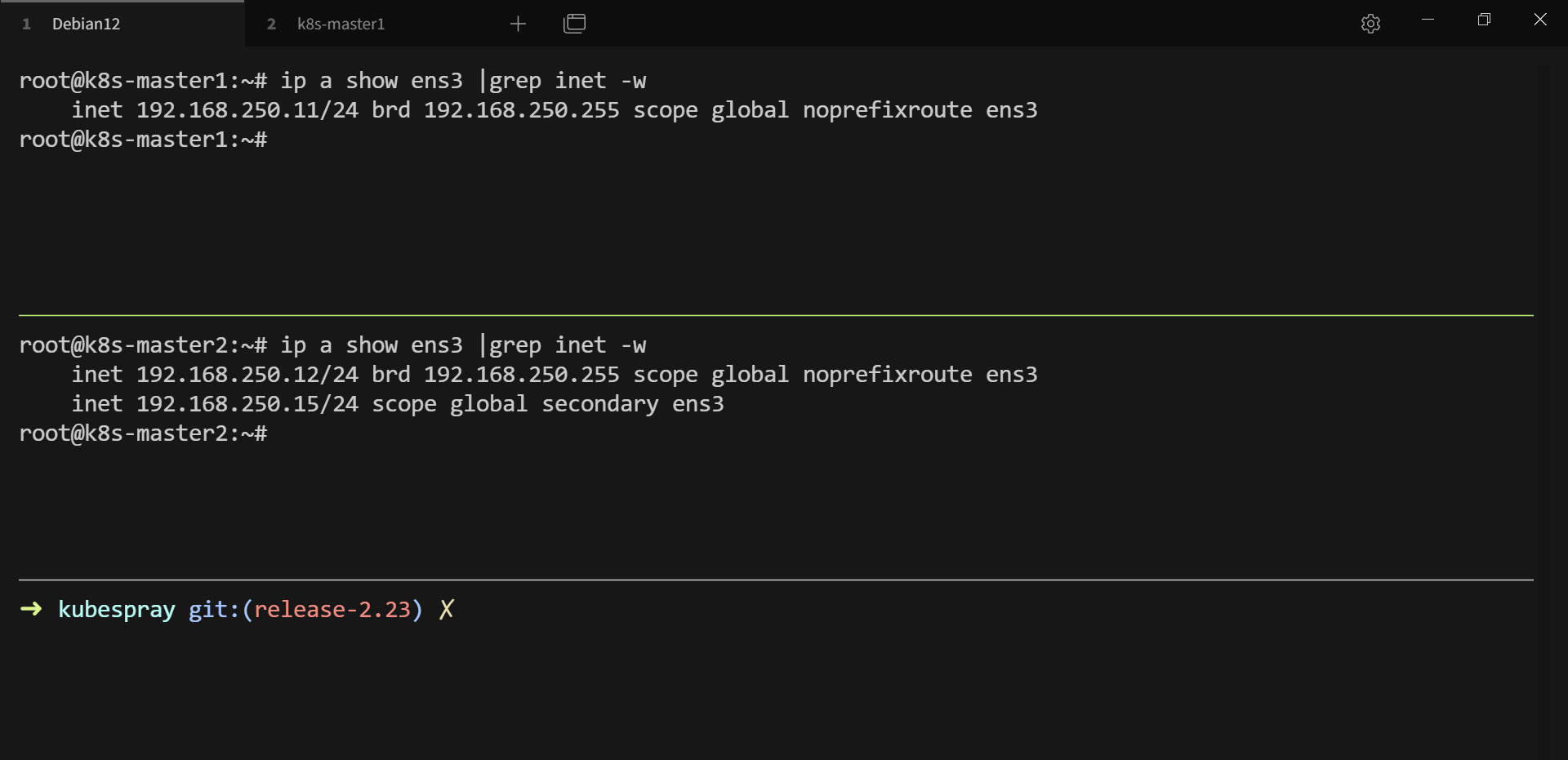







 浙公网安备 33010602011771号
浙公网安备 33010602011771号